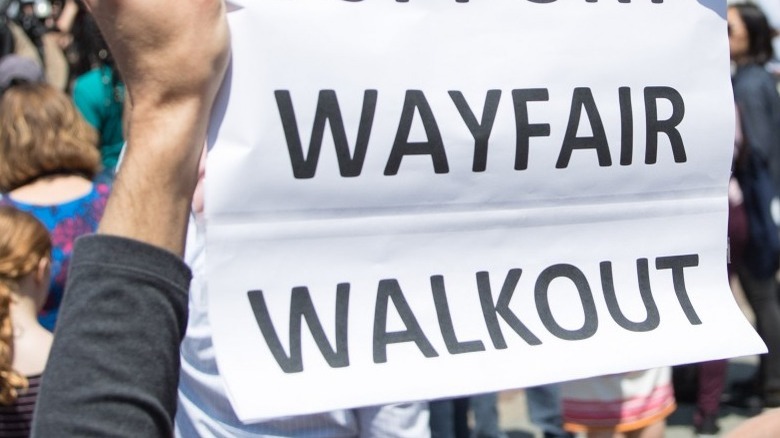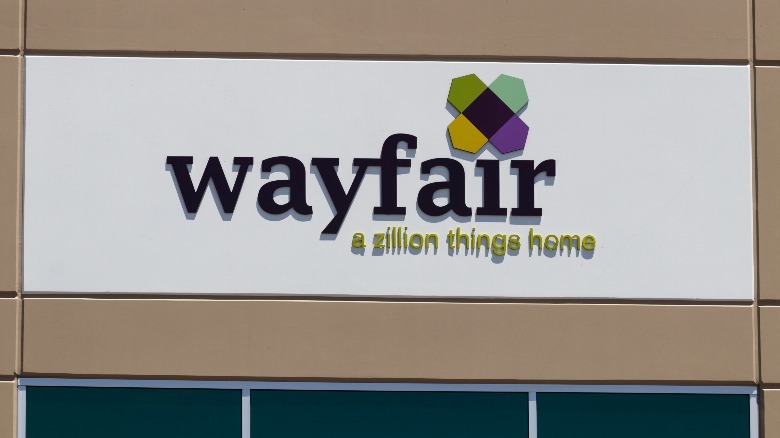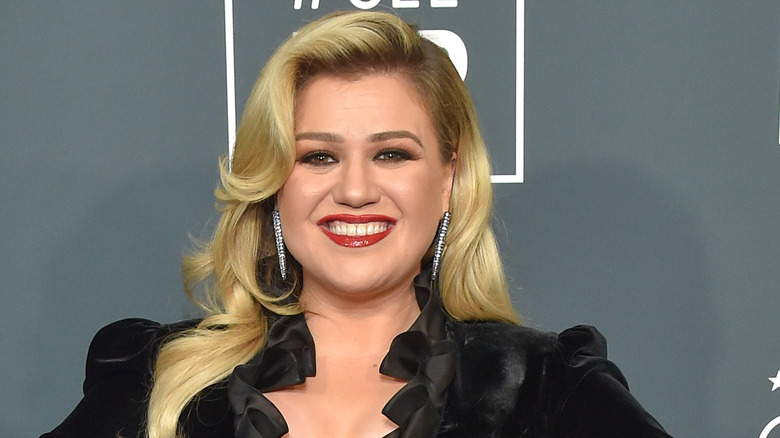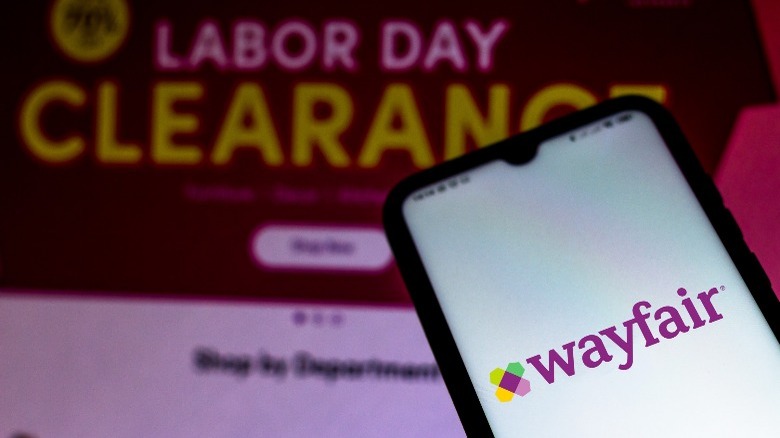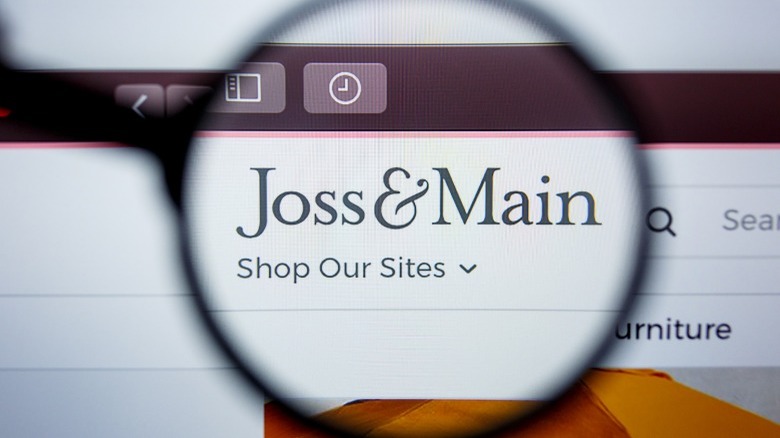The Untold Truth About Wayfair
Practically everyone has heard of or shopped at Wayfair these days. The company is one of the world's largest and fastest-growing home retailers. With an audience of 23.6 million active consumers, more than 33 million products, and 23,000 suppliers, it's easy to see why so many people turn to this popular website. You can get everything from a living room rug to a kitchen island to a decorative knick-knack on the website, making it a one-stop shop for all things decor. But while you might be familiar with the massive online retailer, we thought it would be interesting to dive into some of the lesser-known facts about Wayfair.
We'll take a deep dive into everything from its lesser-known private brands to its PR troubles with walkouts. The store is also trying to compete with retail giants like Amazon in clever ways, and is also experimenting with brick and mortar locations, bringing a HomeGoods-like experience to select states. Here's everything you didn't know about Wayfair.
The Wayfair walkout
Something not many people know about is called the "Wayfair Walkout." According to Vox, this was an event that happened in 2019 involving employees of Wayfair who protested the sale of bedroom furniture to a border detention facility for children in Texas. The movement's Twitter account, @wayfairwalkout, stated that 547 employees signed a petition protesting the sale. When Wayfair CEO and co-founder Niraj Shah responded with a letter, which solidified the company's decision to honor the sale, the employees staged a walkout the following afternoon. The employees had requested an alternative of donating the proceeds to an organization called RAICES that provides low-cost or free legal services for immigrants.
The detention facility, BCFS, issued a statement to Vox in response: "We believe youth should sleep in beds with mattresses." The U.S. Department of Health and Human Services also shared a statement, writing, "Those who are protesting Wayfair's sale of beds for unaccompanied alien children need to ask themselves what the alternative should be to keep the children comfortable." The event attracted major political and public attention, with support for the employees from people such as Rep. Alexandria Ocasio-Cortez, Rep. Ayanna Pressley, and Senator Elizabeth Warren. However, the event did not seem to result in any further verified action.
It owns five different brands
According to Dataramos, Wayfair owns five "brands," or company websites. They are Wayfair.com, AllModern, Birch Lane, Joss & Main, and Perigold. According to Vox, Wayfair is the "catch-all" site or "brand" where you can find nearly all of its products — yep, all 33 million. The other websites feature home products that are grouped by "loose themes."
Perigold is the high-end company website geared toward shoppers with larger budgets and glamorous tastes. Just for fun, we took a quick peek at some merchandise, and if $800+ end tables (marked as "sale" with a $2,400+ price tag crossed out) are your thing, this is the website for you. Next, we have Joss & Main, which focuses on blending contemporary with traditional aesthetics. It has a wide variety of styles and a more reasonable price range. Birch Lane also has a tasteful, classic selection, but with a slightly higher price range. Specifically, it focuses on farmhouse, rustic, coastal, and traditional designs. Lastly, AllModern is — yep, just like it sounds — thoroughly modern. It blends popular mid-century modern silhouettes with contemporary tastes. Its merchandise is about the same price range as Birch Lane, but "trés vogue." You won't find anything outdated at AllModern.
First physical store opened in 2019
CNBC reported in 2019 that Wayfair was preparing to open its very first brick-and-mortar store in its home state of Massachusetts. Unsure if shoppers wanted to take their shopping away from the laptop, the company tested several temporary pop-up locations in local malls over the holiday season and learned there's a need to go analog. With the opening of the first physical store, Wayfair wanted to "bring its website to life."
But the store offered more than just aisle perusing — an in-house design team was put in place to help customers who struggled with interior design, something the website could not do. It was seen as the next step in the growth of the company. The business is headquartered in Boston and had two warehouses at the time, in Kentucky and Utah (via CBS Boston). But other than a few large warehouses, the mega-company relies on a drop-shipping model instead of holding its own inventory. The new brick-and-mortar locations were supposed to shake up that model, but it was only open for 15 months and closed in December 2020 (via Home Textiles Today). While there was no public explanation for why it closed, some speculate that it was simply a test run for future brick-and-mortar stores. One tip-off was that the home goods store was in an unusually small location. According to Forbes, most furniture stores have at least 40,000 square feet, but the Massachusettes store measured about 3,700 square feet. "That's a pretty small size for us to bring our brand to life," spokeswoman Jane Carpenter said.
Kelly Clarkson becomes its first brand ambassador in 2020
According to Wayfair, in 2020, the singer/actress/voice coach/talk show host Kelly Clarkson was teaming up with Wayfair as its first U.S. brand ambassador. This included the ad campaign "Home: You Got This," which would launch over TV, digital, and social media. In the press release on Business Wire, Wayfair's Director of Brand Marketing, Courtney Lawrie, spoke about how and why the company chose Clarkson. Apparently, it polled its customers for feedback, and Clarkson resonated with them the most. She stood out, bringing her charisma and authenticity to the table — and now to the Wayfair brand.
Additionally, Clarkson inspired and curated a line of new products for the launch, which played off her Southern Texas roots. The line — called Kelly Clarkson Home — contained everything needed for tasteful home furnishings inspired by the well-liked star. "I'm so excited to team up with Wayfair to connect with their shoppers and show them how simple it is to turn their home into a place that feels as special as they are," Clarkson said in a statement. "I'm stepping in to inspire and help everyone realize that they really can make their vision a reality!" This partnership wasn't a one-time deal; instead, Clarkson is still curating country-chic collections for the brand, delighting fans everywhere. Expect to find everything from grandmillennial bed frames to vintage-inspired rugs to chic outdoor sets in her collections.
It's still not profitable
What? But how can this be, you ask? Well, it's — complicated. At the end of 2021, Seeking Alpha did a report on Wayfair and its profitability trends thus far. Basically, the company has been slowly climbing into the black, posting its first profits ever in 2020, only to dip back into the red in 2021. Wayfair presently has a solid 33% of the market share in online home furnishings, so what are some of its costs? Two main things cut into its profits: advertising and shipping costs. Compared with Amazon, Wayfair covers 100% of the shipping costs and does not recoup any of this. Amazon, on the other hand, charges partners 10% to 15% plus additional fees. It also charges Prime members a monthly subscription fee.
Additionally, it was noted in Retail Dive that Wayfair was the only one out of the top 10 e-commerce retailers to report losses for 2021. Some of the others were Amazon and eBay, both of which saw 15% to 20% gains on average. Some experts say its losses are beginning to widen significantly, making it even more difficult to recoup. Wayfair went public in 2014 and has publicly operated at a loss ever since. "There is a fundamental weakness in Wayfair's business model: It needs considerably larger volumes and many more regular customers to attain profitability," GlobalData U.S. Consulting Director Neil Saunders said in a statement. However, the company is still the largest home goods retailer in the country, and as such, is not in danger of going out of business anytime soon.
Way Day was created in response to Prime Day
At first, Wayfair found one of its biggest rivals in Amazon, the e-commerce giant. Wayfair was serious about being a contender, but Amazon was a step ahead of it with its made~up holiday, "Prime Day," the one day a year it offers unheard-of savings to everyone. The first Prime Day was announced in 2015 and has remained a popular sales event ever since.
According to The Seattle Times, the shopping website most popular in the east, Alibaba, profited greatly from a similar marketing tactic called "Singles Day." Chinese college students initially created Singles Day in response to Valentine's Day as an alternative celebration for single students. Then the popular e-commerce website Alibaba adopted the made-up holiday as its version of a sale holiday, which has been popular ever since.
Wayfair was not deterred by these successful campaigns but emboldened. In response, the brand christened the first "Way Day" on April 25th, 2018. Wayfair said its Way Day specials would rival the Black Friday deals people wait all year for, building the hype for its new sale day right from the gate. The idea was to launch it in the spring, when people are in the middle of moving or spring cleaning, and looking to spruce up their homes with new things as they get rid of old items. The day was a hit and has been every year since, gaining momentum and netting one of its biggest sale days of the year.
The Wayfair decision
There was a Supreme Court decision in a landmark case that has gone down in history as "the Wayfair decision," affecting all online businesses that sell a certain amount within any state. It was "South Dakota v. Wayfair, Inc. et al," according to TaxConnex. Before this case, the law stated that a business had to have a physical presence within the state to be liable to collect taxes. (However, it is also important to note that every state has its own laws concerning this.)
With the Wayfair decision and the age of the internet, however, this physical presence is no longer needed to require a business to collect and remit sales tax in some states. Instead, at a certain level of sales, any business, whether fully online or physically present, must collect sales tax for the state in which its sales occur. With the internet came unprecedented situations in which no laws had been established to govern this type of commerce. Suddenly, states were complaining of missing out on potentially billions of dollars in revenue from sales tax. The Supreme Court argued that these online titans created tax havens through this law loophole, cheating the government. "In effect, it is a judicially created tax shelter for businesses that limit their physical presence in a State but sell their goods and services to the State's consumers, something that has become easier and more prevalent as technology has advanced," the opinion read. Now, each state has its own tax law that triggers this liability, but this amount can vary greatly from state to state.
Anyone can sell on Wayfair under these conditions
Amazingly, Wayfair offers massive opportunities for suppliers who want to test certain aspects of their business by using its popular platform. Any company that meets two major requirements can sell on Wayfair.com, and there are plenty of reasons why this would be desirable. According to eCommerce Next, the two hurdles are: having drop-shipping capabilities, and having sufficient insurance coverage.
In terms of drop-shipping, when a customer places their order, Wayfair doesn't dispatch it from its personal warehouse. Instead, the order goes to the business that owns the product, and that business packages and ships the product, with Wayfair footing the shipping costs. If there are issues with the product or it needs to be returned, Wayfair doesn't step in. Instead, it's all on the business's shoulders — Wayfair just acts as the broker or middle man in the sale. However, because of the platform's proven popularity and its global audience, the business can reach a wider net of customers than before. Suppliers can sell more of their products to a worldwide audience and spend less money on advertising and marketing. It provides a perfect solution for many businesses. As for the second requirement concerning insurance, Wayfair requires businesses to have a minimum of $1 million in product liability coverage, which minimizes its risk.
Wayfair wins title of 'Best Places to Work' for LGBTQ+ equality
In 2022, Wayfair announced on Twitter that it once again won the title of "Best Place to Work for LGBTQ+ Equality." The award is given by an organization called the HRC, which stands for Human Rights Campaign, the nation's largest human rights organization. According to the @HRC Twitter page, there are many anti-LGBTQ+ bills it is currently fighting against, but it gives out this award every year to celebrate those who are supporting the LGBTQ+ community. And for two consecutive years, Wayfair has proudly won this title. But how, you ask? Great question!
Large corporations, in particular are graded according to their CEI, or corporate equality index score. This is described on the HRC's website as a national tool used to determine the year-over-year growth of big businesses adopting more inclusive policies concerning the LGBTQ+ community. This helps employers show their commitment to equality for all employees and future employees. Companies who actively participated in 2022 totaled 1,271. Of these, 842 received a perfect score of 100, winning them the title of being one of the "Best Places to Work for LGBTQ+ Equality." Obviously, this designation is important to the Wayfair name, and is a positive achievement for any corporation in today's world.
Three physical stores opening in 2022
According to Wayfair, three additional physical stores in Massachusetts are opening in 2022, representing website companies AllModern and Joss & Main. The goal is to open stores representing all five company brands in the next two years, but it is testing the waters with these two first. (In fact, there are already rumbling gs that a Wayfair store will be opening in Chicago, as per NBC.) "With our first-ever AllModern and Joss & Main retail stores, we are introducing a new kind of omnichannel shopping experience powered by the Wayfair platform, inviting our customers to engage with the brands they know and love in an innovative format that blends the best of in-store and online shopping," Karen McKibbin, Head of Physical Retail, Wayfair, said in a press release.
According to Retail Dive, two AllModern stores and one Joss & Main shop will be opening. The AllModern stores will be located in Dedham, Massachusetts, and the Joss & Main store has its grand opening in Burlington, Massachusetts. To diversify itself from other home goods stores, these three shops will offer in-house designing help and free shipping — perfect for bulk purchases that won't fit inside a car.
The company has its original roots in Boston, but until recently did not have a physical presence, despite its huge internet following and dominance of the home products industry. Today, despite facing considerable challenges to becoming profitable, the company continues to move forward, as witnessed by continued growth and aggressive advertising. It's believed that these brick-and-mortar stores will help offset some of those losses. Its dominance of the home goods and furnishings industry seems indicative of consumers' desire to find the largest selection at one destination. One adage comes to mind: slow and steady wins the race. Only time will tell for Wayfair.

